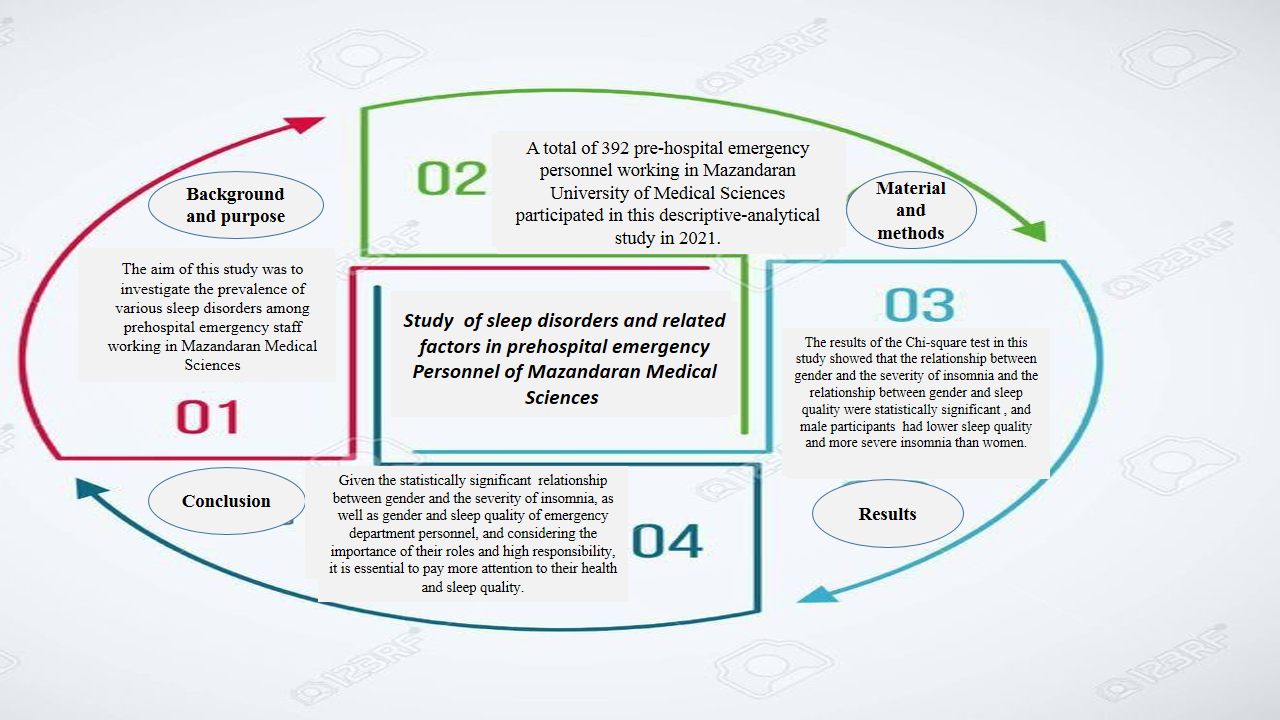Volume 35, Issue 250 (11-2025)
J Mazandaran Univ Med Sci 2025, 35(250): 106-118 |
Back to browse issues page
Download citation:
BibTeX | RIS | EndNote | Medlars | ProCite | Reference Manager | RefWorks
Send citation to:



BibTeX | RIS | EndNote | Medlars | ProCite | Reference Manager | RefWorks
Send citation to:
Setareh J, Rafiei M, Aminimanesh A, Rahmati F, Ahmadi H. Study of sleep disorders and related factors in prehospital emergency Personnel of Mazandaran Medical Sciences. J Mazandaran Univ Med Sci 2025; 35 (250) :106-118
URL: http://jmums.mazums.ac.ir/article-1-21777-en.html
URL: http://jmums.mazums.ac.ir/article-1-21777-en.html
Abstract: (559 Views)
Background and purpose: The aim of this study was to assess the prevalence of daytime sleepiness, risk of obstructive sleep apnea, severity of insomnia, restless legs syndrome, and sleep quality among prehospital emergency personnel working in Mazandaran Medical Sciences.
Materials and methods: The present descriptive-analytical study was conducted using a census approach among all personnel (staff and operational) of the pre-hospital emergency department of Mazandaran University of Medical Sciences in 2021. A total of 392 personnel participated in this study. To collect data, the Epworth Sleepiness Scale (ESS), Obstructive Apnea Risk Questionnaire (STOP-BANG) , Pittsburgh Sleep Quality Index Questionnaire (PSQI), Insomnia Severity Index (ISI), and Restless Legs Severity Severity Scale (RLS) were used descriptive and inferential statistics such as Pearson's chi-square test were used to analyze the data.
Results: In this study, 392 participants were evaluated, of whom 43 were female (11%) and 349 were male (89%). The mean scores of the individuals in the ISI questionnaire were 8.54, in the RLS questionnaire 6.41, in the PSQI questionnaire 4.80, in the ESS questionnaire 5.81, and in the STOP-BANG 1.9. The results of the Chi-square test in this study showed that the relationship between gender and the severity of insomnia and the relationship between gender and sleep quality were statistically significant, and in the present study, male participants had lower sleep quality and more severe insomnia than women.
Conclusion: Given the statistically significant relationship between gender and the severity of insomnia, as well as gender and sleep quality of emergency department personnel, and considering the importance of their roles and high responsibility, it is essential to pay more attention to their health and sleep quality and conduct further studies to provide optimal conditions for improving these two variables.
Materials and methods: The present descriptive-analytical study was conducted using a census approach among all personnel (staff and operational) of the pre-hospital emergency department of Mazandaran University of Medical Sciences in 2021. A total of 392 personnel participated in this study. To collect data, the Epworth Sleepiness Scale (ESS), Obstructive Apnea Risk Questionnaire (STOP-BANG) , Pittsburgh Sleep Quality Index Questionnaire (PSQI), Insomnia Severity Index (ISI), and Restless Legs Severity Severity Scale (RLS) were used descriptive and inferential statistics such as Pearson's chi-square test were used to analyze the data.
Results: In this study, 392 participants were evaluated, of whom 43 were female (11%) and 349 were male (89%). The mean scores of the individuals in the ISI questionnaire were 8.54, in the RLS questionnaire 6.41, in the PSQI questionnaire 4.80, in the ESS questionnaire 5.81, and in the STOP-BANG 1.9. The results of the Chi-square test in this study showed that the relationship between gender and the severity of insomnia and the relationship between gender and sleep quality were statistically significant, and in the present study, male participants had lower sleep quality and more severe insomnia than women.
Conclusion: Given the statistically significant relationship between gender and the severity of insomnia, as well as gender and sleep quality of emergency department personnel, and considering the importance of their roles and high responsibility, it is essential to pay more attention to their health and sleep quality and conduct further studies to provide optimal conditions for improving these two variables.
Type of Study: Research(Original) |
Subject:
Epidemiology
Send email to the article author
| Rights and permissions | |
 |
This work is licensed under a Creative Commons Attribution-NonCommercial 4.0 International License. |







